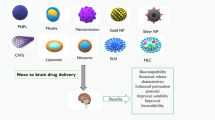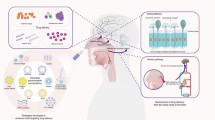Abstract
Purpose
Zonisamide clinical indications are expanding beyond the classic treatment of epileptic seizures to Parkinson’s disease and other neurodegenerative diseases. However, the systemic safety profile of zonisamide may compromise its use as a first-line drug in any clinical condition. Since zonisamide is marketed as oral formulations, the present study aimed at exploring the potential of the intranasal route to centrally administer zonisamide, evaluating the systemic bioavailability of zonisamide and comparing its brain, lung and kidney pharmacokinetics after intranasal, oral and intravenous administrations.
Methods
In vitro cell studies demonstrated that zonisamide and proposed thermoreversible gels did not affect the viability of RPMI 2650 or Calu-3 cells. Thereafter, male CD-1 mice were randomly administered with zonisamide by oral (80 mg/kg), intranasal or intravenous (16.7 mg/kg) route. At predefined time points, animals were sacrificed and plasma and tissues were collected to quantify zonisamide and describe its pharmacokinetics.
Results
Intranasal route revealed a low absolute bioavailability (54.95%) but the highest value of the ratio between the area under the curve (AUC) between brain and plasma, suggesting lower systemic adverse events and non-inferior effects in central nervous system comparatively to intravenous and oral routes. Furthermore, drug targeting efficiency and direct transport percentage into the brain were 149.54% and 33.13%, respectively, corroborating that a significant fraction of zonisamide suffers direct nose-to-brain transport. Lung and kidney exposures obtained after intranasal administration were lower than those observed after intravenous injection.
Conclusions
This pre-clinical investigation demonstrates a direct nose-to-brain delivery of zonisamide, which may be a promising strategy for the treatment of central diseases.






Similar content being viewed by others
Abbreviations
- AUC:
-
Area under drug concentration-time curve
- AUCt :
-
Area under drug concentration-time curve from time zero to the time of last measurable concentration
- AUCextrap :
-
Extrapolated area under drug concentration-time curve
- AUCinf :
-
area under drug concentration-time curve from time zero to infinity
- BBB:
-
Blood-brain barrier
- BbrainIN/IV :
-
Brain bioavailability between IN and IV routes
- Cmax :
-
Maximum concentration
- CNS:
-
Central nervous system
- CYP:
-
Cytochrome P450
- CV:
-
Coefficient of variation
- DRE:
-
Drug-resistant epilepsy
- DTE:
-
Drug targeting efficiency
- DTP:
-
Direct transport percentage
- FAbs :
-
Absolute bioavailability
- FRel :
-
Relative bioavailability
- HPLC:
-
High performance liquid chromatography
- IN:
-
Intranasal
- IV:
-
Intravenous
- LLOQ:
-
Lower limit of quantification
- SD:
-
Standard deviation
- SEM:
-
Standard error of the mean
- SMPA:
-
Sulfamoylacetylphenol glucuronide
- tmax :
-
Time to reach the maximum concentration
References
Park KM, Lee BI, Shin KJ, Ha SY, Park J, Kim SE, et al. Efficacy, tolerability, and blood concentration of zonisamide in daily clinical practice. J Clin Neurosci. 2019;61:44–7.
Sano H, Nambu A. The effects of zonisamide on L-DOPA-induced dyskinesia in Parkinson's disease model mice. Neurochem Int. 2019;124:171–80.
Iwaki H, Tagawa M, Iwasaki K, Kawakami K, Nomoto M. Comparison of zonisamide with non-levodopa, anti-Parkinson's disease drugs in the incidence of Parkinson's disease-relevant symptoms. J Neurol Sci. 2019;402:145–52.
Nishijima H, Miki Y, Ueno S, Tomiyama M. Zonisamide enhances motor effects of levodopa, not of Apomorphine, in a rat model of Parkinson's disease. Parkinson’s Dis. 2018;2018:8626783.
Limmer AL, Holland LC, Loftus BD. Zonisamide for cluster headache prophylaxis: a case series. Headache. 2019;59(6):924–9.
Martinez-Avila JC, Garcia Bartolome A, Garcia I, Dapia I, Tong HY, Diaz L, et al. Pharmacometabolomics applied to zonisamide pharmacokinetic parameter prediction. Metabol: Off J Metabol Soc. 2018;14(5):70.
Kanner AM, Ashman E, Gloss D, Harden C, Bourgeois B, Bautista JF, et al. Practice guideline update summary: efficacy and tolerability of the new antiepileptic drugs I: treatment of new-onset epilepsy: report of the guideline development, dissemination, and implementation Subcommittee of the American Academy of neurology and the American Epilepsy Society. Neurology. 2018;91(2):74–81.
Hershey LA, Coleman-Jackson R. Pharmacological Management of Dementia with Lewy bodies. Drugs Aging. 2019;36(4):309–19.
Sano H, Murata M, Nambu A. Zonisamide reduces nigrostriatal dopaminergic neurodegeneration in a mouse genetic model of Parkinson's disease. J Neurochem. 2015;134(2):371–81.
Reimers A, Ljung H. An evaluation of zonisamide, including its long-term efficacy, for the treatment of focal epilepsy. Expert Opin Pharmacother. 2019;20(8):909–15.
Kubota M, Nishi-Nagase M, Sakakihara Y, Noma S, Nakamoto M, Kawaguchi H, et al. Zonisamide - induced urinary lithiasis in patients with intractable epilepsy. Brain Dev. 2000;22(4):230–3.
Jion YI, Raff A, Grosberg BM, Evans RW. The risk and management of kidney stones from the use of topiramate and zonisamide in migraine and idiopathic intracranial hypertension. Headache. 2015;55(1):161–6.
Bejjanki H, Bird V, Ruchi R. Letter to the editor regarding the manuscript "efficacy, tolerability, and blood concentration of zonisamide in daily clinical practice". J Clin Neurosci: Off J Neurosurg Soc Aust. 2019;63:283.
Sills G, Brodie M. Pharmacokinetics and drug interactions with zonisamide. Epilepsia. 2007;48(3):435–41.
McCleane G. Pharmacological management of neuropathic pain. CNS drugs. 2003;17(14):1031–43.
Levy RH, Ragueneau-Majlessi I, Garnett WR, Schmerler M, Rosenfeld W, Shah J, et al. Lack of a clinically significant effect of zonisamide on phenytoin steady-state pharmacokinetics in patients with epilepsy. J Clin Pharmacol. 2004;44(11):1230–4.
Frampton JE, Scott LJ. Zonisamide: a review of its use in the management of partial seizures in epilepsy. CNS drugs. 2005;19(4):347–67.
Nakasa H, Nakamura H, Ono S, Tsutsui M, Kiuchi M, Ohmori S, et al. Prediction of drug-drug interactions of zonisamide metabolism in humans from in vitro data. Eur J Clin Pharmacol. 1998;54(2):177–83.
Loscher W, Klotz U, Zimprich F, Schmidt D. The clinical impact of pharmacogenetics on the treatment of epilepsy. Epilepsia. 2009;50(1):1–23.
Saruwatari J, Ishitsu T, Nakagawa K. Update on the Genetic Polymorphisms of Drug-Metabolizing Enzymes in Antiepileptic Drug Therapy. Pharmaceuticals (Basel, Switzerland). 2010;3(8):2709–32.
Goto S, Seo T, Murata T, Nakada N, Ueda N, Ishitsu T, et al. Population estimation of the effects of cytochrome P450 2C9 and 2C19 polymorphisms on phenobarbital clearance in Japanese. Ther Drug Monit. 2007;29(1):118–21.
Vitorino C, Silva S, Bicker J, Falcao A, Fortuna A. Antidepressants and nose-to-brain delivery: drivers, restraints, opportunities and challenges. Drug Discov Today. 2019;24(9):1911–23.
Goncalves J, Bicker J, Gouveia F, Liberal J, Oliveira RC, Alves G, et al. Nose-to-brain delivery of levetiracetam after intranasal administration to mice. Int J Pharm. 2019;564:329–39.
Sabir F, Ismail R, Csoka I. Nose-to-brain delivery of antiglioblastoma drugs embedded into lipid nanocarrier systems: status quo and outlook. Drug Discov Today. 2019.
Martins PP, Smyth HDC, Cui Z. Strategies to facilitate or block nose-to-brain drug delivery. Int J Pharm. 2019;570:118635.
Wang Z, Xiong G, Tsang WC, Schatzlein AG, Uchegbu IF. Nose-to-brain delivery. J Pharmacol Exp Ther. 2019;370(3):593–601.
Agrawal M, Saraf S, Saraf S, Antimisiaris SG, Chougule MB, Shoyele SA, et al. Nose-to-brain drug delivery: an update on clinical challenges and progress towards approval of anti-Alzheimer drugs. J Control Rel: Off J Control Rel Soc. 2018;281:139–77.
Crowe TP, Greenlee MHW, Kanthasamy AG, Hsu WH. Mechanism of intranasal drug delivery directly to the brain. Life Sci. 2018;195:44–52.
Romanelli MC, Gelardi M, Fiorella ML, Tattoli L, Di Vella G, Solarino B. Nasal ciliary motility: a new tool in estimating the time of death. Int J Legal Med. 2012;126(3):427–33.
O'Brien J, Wilson I, Orton T, Pognan F. Investigation of the Alamar blue (resazurin) fluorescent dye for the assessment of mammalian cell cytotoxicity. Eur J Biochem. 2000;267(17):5421–6.
Goncalves J, Alves G, Bicker J, Falcao A, Fortuna A. Development and full validation of an innovative HPLC-diode array detection technique to simultaneously quantify lacosamide, levetiracetam and zonisamide in human plasma. Bioanalysis. 2018;10(8):541–57.
EMA. Guideline on bioanalytical method validation. 2012.
EMA. ICH Harmonised Guideline M10 on Bioanalytical Method Validation - step 2b. 2019.
FDA. Bioanalytical Method Validation Guidance for Industry. 2018.
Raval N, Barai P, Acharya N, Acharya S. Fabrication of peptide-linked albumin nanoconstructs for receptor-mediated delivery of asiatic acid to the brain as a preventive measure in cognitive impairment: optimization, in-vitro and in-vivo evaluation. Artificial cells, nanomedicine, and biotechnology. 2018;46(sup3):S832-s46.
Fatouh AM, Elshafeey AH, Abdelbary A. Agomelatine-based in situ gels for brain targeting via the nasal route: statistical optimization, in vitro, and in vivo evaluation. Drug Del. 2017;24(1):1077–85.
Fatouh AM, Elshafeey AH, Abdelbary A. Intranasal agomelatine solid lipid nanoparticles to enhance brain delivery: formulation, optimization and in vivo pharmacokinetics. Drug Des, Devel Ther. 2017;11:1815–25.
Katare YK, Piazza JE, Bhandari J, Daya RP, Akilan K, Simpson MJ, et al. Intranasal delivery of antipsychotic drugs. Schizophr Res. 2017;184:2–13.
Kozlovskaya L, Abou-Kaoud M, Stepensky D. Quantitative analysis of drug delivery to the brain via nasal route. J Control Rel: Off J Control Rel Soc. 2014;189:133–40.
Pires PC, Santos AO. Nanosystems in nose-to-brain drug delivery: a review of non-clinical brain targeting studies. J Control Rel: Off J Control Rel Soc. 2018;270:89–100.
Fortuna A, Alves G, Serralheiro A, Sousa J, Falcao A. Intranasal delivery of systemic-acting drugs: small-molecules and biomacromolecules. Eur J Pharm Biopharm. 2014;88(1):8–27.
Serralheiro A, Alves G, Fortuna A, Falcao A. Direct nose-to-brain delivery of lamotrigine following intranasal administration to mice. Int J Pharm. 2015;490(1–2):39–46.
Sousa J, Alves G. Intranasal Del Topically-Acting Levofloxacin Rats: Proof-of-Conc Pharmacok Study. 2017;34(11):2260–9.
Cunha-Filho MS, Alvarez-Lorenzo C, Martinez-Pacheco R, Landin M. Temperature-sensitive gels for intratumoral delivery of beta-lapachone: effect of cyclodextrins and ethanol. TheScientificWorldJournal. 2012;2012:126723.
Zahir-Jouzdani F, Wolf JD, Atyabi F, Bernkop-Schnurch A. In situ gelling and mucoadhesive polymers: why do they need each other? Expert Opin Del. 2018;15(10):1007–19.
Hiemke C, Bergemann N, Clement HW, Conca A, Deckert J, Domschke K, et al. Consensus guidelines for therapeutic drug monitoring in Neuropsychopharmacology: update 2017. Pharmacopsychiatry. 2018;51(1–02):e1.
Jacob S, Nair AB. An updated overview on therapeutic drug monitoring of recent antiepileptic drugs. Drugs in R&D. 2016;16(4):303–16.
Ruigrok MJ, de Lange EC. Emerging insights for translational pharmacokinetic and pharmacokinetic-Pharmacodynamic studies: towards prediction of nose-to-brain transport in humans. AAPS J. 2015;17(3):493–505.
Kwan P, Arzimanoglou A, Berg AT, Brodie MJ, Allen Hauser W, Mathern G, et al. Definition of drug resistant epilepsy: consensus proposal by the ad hoc task force of the ILAE commission on therapeutic strategies. Epilepsia. 2010;51(6):1069–77.
Leandro K, Bicker J, Alves G, Falcao A, Fortuna A. ABC transporters in drug-resistant epilepsy: mechanisms of upregulation and therapeutic approaches. Pharmacol Res. 2019;144:357–76.
Lochhead JJ, Wolak DJ, Pizzo ME, Thorne RG. Rapid transport within cerebral perivascular spaces underlies widespread tracer distribution in the brain after intranasal administration. J Cereb Blood Flow Metab: Off J Int Soc Cereb Blood Flow Metab. 2015;35(3):371–81.
ACKNOWLEDGMENTS AND DISCLOSURES
The authors acknowledge to Fundo Europeu de Desenvolvimento Regional (FEDER) funds through Portugal 2020 in the scope of the Operational Programme for Competitiveness and Internationalisation, and Fundação para a Ciência e Tecnologia (FCT) I.P./MCTES, Portuguese Agency for Scientific Research, through national funds (PIDDAC) within the scope of the research project CENTRO-01-0145-FEDER-03075 and POCI-01-0145-FEDER-030478.
Author information
Authors and Affiliations
Corresponding author
Additional information
Publisher’s Note
Springer Nature remains neutral with regard to jurisdictional claims in published maps and institutional affiliations.
Rights and permissions
About this article
Cite this article
Gonçalves, J., Alves, G., Carona, A. et al. Pre-Clinical Assessment of the Nose-to-Brain Delivery of Zonisamide After Intranasal Administration. Pharm Res 37, 74 (2020). https://doi.org/10.1007/s11095-020-02786-z
Received:
Accepted:
Published:
DOI: https://doi.org/10.1007/s11095-020-02786-z




